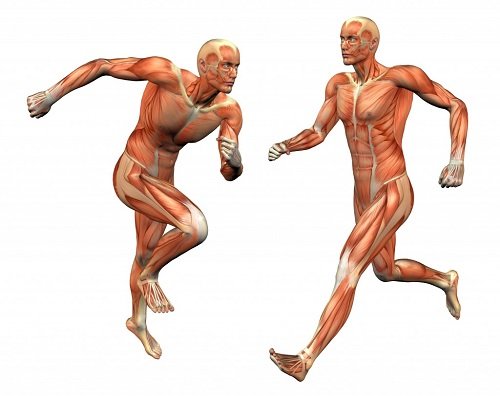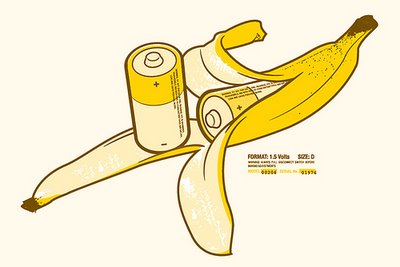MedicalMonday #1: From the banana to energy
We all need it!
For living, for breathing, for just sitting around, studying, having wild discussions with our friends, going for a walk, playing soccer, running, training and so on.
We need it for everything.
Energy.
But where does it come from? How becomes the banana, sandwich or steak we eat the energy we need?
What should we eat to get the most power at the right time?
How can we work with our nutrition, play tricks on our body and have the effect we want?

image source: http://hd-m.com/human-muscle-energy/
From the mouth to the muscle
How can our nutrition become the kind of energy our body is able to use?
The connecting link between the food we eat and the effect it causes in our cells is the so-called adenosine triphosphate, ATP.
Everything we eat, no matter if carbs, protein or fat, lead through different pathways to the end product ATP. By converting it to adenosine diphosphate, ADP, energy is set free and can be used by our cells, I wanna concentrate on muscle cells, to perform a contraction, for example. Our body is even able to recycle the incurred ADP and regenerate ATP. It is kind of the "molecular currency" our cells are able to exploit.
The upcoming question is:
How does our nutrition become ATP?

image source: http://ajstimeout.com/fyi/bananas/bananas.htm
Our muscles have a really small stock of ATP, that can be used for high intensity moves for a few seconds. The advantage of this in the muscle prevented ATP is, that it is immediately available, the problem, that you won't be able to do even a hundred meter sprint just by the resulting energy.
Therefor, the ATP supply needs to be preserved by exogenous energy.
There are different pathways depending on which substrate we are talking about, leading to the end product ATP. Each of them is pretty complicated and includes dozens of enzymes and intermediate substrates. Not going into detail, I will give a short overview about the energy supply of carbs, fats and proteins.
CARBS
Carbs can be taken for energy metabolism from the carbs-storage, so called glycogen in our liver and muscles or a little amount of glucose, circulating in our blood. The glycogen depot in our liver amounts 50-110 g glycogen which comes up to 200 - 450 kcal, while the muscle glycogen contains up to 2000 kcal. Nevertheless, it has to be said that it only can be resorted to the depots of muscle glycogen which are actually located in the working muscle.
There are two ways of producing ATP out of carbs:
- The fast and inefficient way, producing ATP without oxygen but with the metabolic drop-off lactate, which is able to synthesize 2 mol ATP out of 1 mol glycogen within seconds.
- And the slower, but more efficient way of producing 36 mol ATP out of the same amount of glycogen by aerobic, oxygen using process.
It depends on the intensity of training if the necessary energy can be taken from aerobic way or the body needs to synthesize ATP by the faster, anaerobic pathway as well. The disadvantage of this lactate producing process, is, that at some point, the body is not able to compensate the lactate production any more and this lactic acid aerates in our cells. Thereof, we get the feeling of "heavy legs", our body becomes more and more acid and as a compensation mechanism we start to hyperventilate.
By starting our training too intense, for example with a too high speed at a marathon, all our glycogen resources are blown off much too fast and the cells try to get their last energy from the circulating glucose in our blood. A hypoglycemia is the result. A strong feeling of hunger, fraud, debility (weak knees) and a black out follow.
Once cheerleading at a marathon, I saw three of these phenomena in front of my eyes about 800 meters in front of the finish line.
So, what can be done avoid this situation?
First of all, this is the reason why every runner should have some emergency sugar with him or her during a marathon. Optimal would be about 2 g of glucose per minute.
Second, the body can be tricked:
By drain of the glycogen resources (for example with an interval training), no-carb diet afterwards for three days and then filling the store by consuming amounts of carbs for four days a so called "supercompensation" can be induced. This is a common preparation practice before a competition.
FATS
Fats are buffered in so-called depot-fats subcutaneous, meaning under our skin, in the abdomen, but also in the muscle fiber. While the glycogen storage is empty after about 60 minutes of training, energy of fat depots lasts for many hours and make hard-core competitions like the Ironman or a 24 hour run possible. The more intense the training, the more carb metabolism is used. Still, it is important to know that from beginning on, all metabolic pathways to synthesize energy run off, just the balance varies.
Burning fat is the slowest, but most efficient way. One gram of fat contains more than the double amount of energy carbs and proteins do. A 70 kg man with a fat content of 15% for example, saves 100 000 kcal only in his fat resources. That's why it is so hard to get rid of and why the most effective way is to do low intense, but as long as possible runs or walks.
PROTEIN
Protein is the building block of our cells. Hormones, membranes, blood cells, all is made of protein. The units of proteins are amino acids. There is a small amount of amino acids, that can be used for energy. When this is depleted, "functional proteins", the protein of muscle cells, is taken and converted to ATP. Without protein the muscle cells perish, which is an feared effect of extreme sparklers performing the Tour de France or Ironman for example. To avoid the loss of muscle cells, anabolic substances like steroids, growth hormones or insulin are a often used dopes.
Of course, this phenomena can also happen to hobby athletes who are on a diet or just missed consuming appropriate amounts of protein. Therefor, it is recommended to ingest about 1,3 gram protein per kg weight per day.
Another interesting fact, is that the amino acid glutamine, which plays a big role concerning immune competence and decreases after long and intense training, is the reason for the higher risk of infections in professional competitive sports.
To sum up
The right nutrition at the right time plays a big role concerning not only the effects but also the health aspects of your training. Keeping a few rules in mind can improve the quality of every physical activity and help to avoid setbacks or ineffectiveness.
Nevertheless, it should not be forgotten that enjoyment, motivation and a focused mind are at least as important for a successful healthy training.
"Just as your car runs more smoothly and requires less energy to go faster and farther when the wheels are in perfect alignment, you perform better when your thoughts, feelings, emotions, goals, and values are in balance."
-Brian Tracy

Me, running at Mallorca
Sources:
G. Stummvoll, M.L. Pretterklieber, F. Kainberger Bewegung und Leistung, Schmerz. Block 21 (11. Auflage), facultas
Maud PJ, Foster C: Physiological Assessment of Human Fitness. 2nd ed., Human Kinetics, 2006
McArdle WD et al: Exercise Physiology, energy, nutrition, and human performance. Williams Lippincott & Wilkins, 2009
Disclaimer: This is not a reliable scientifically article. It is a summary of my knowledge and researches, tried to simplify to a level one without medical prior knowledge can understand easily. If you are informed better, please correct me.
Yes I liked ، thank you for the beautiful publication I can add and Unlike the rumors surrounding bananas that cause weight gain, which many people prefer to avoid, especially in weight loss diets, the fact that bananas do not cause obesity, as the content of the banana medium-calorie equivalent to 110 calories, in addition to contain about 3 g of Dietary fiber and 2-3mg of starch resistant to digestion, and therefore helps bananas to feel full without giving a high amount of calories. Medium-sized bananas provide around 17% of the daily needs of vitamin C, a powerful antioxidant that supports the immune system and contributes to the production of collagen, which strengthens the walls of blood vessels and helps heal wounds and build bones. Vitamin C plays an important role in hormone synthesis Thyroxine in the thyroid gland and processes of amino acid metabolism, as well as improving iron absorption
Of course, you could go into detail on different involved processes/circle reactions, but that would probably be far be too much content for one post.^^
As it is, it's a nice overview on the core of human metabolism. Thanks!
Ja das stimmt, finde es schwierig..einerseits ist diese Zusammenfassung für Leute mit Vorwissen natürlich nichts neues und viel zu oberflächlich, andererseits wäre es so viel Information auf einmal für diejenigen ohne Vorwissen
Hab mich dann dafür entschieden, es diesmal so überblicksmäßig zu halten weil ich die Leute nicht gleich mit komplizierten biochem. Kreisläufen erschrecken wollte :P
Aber vielleicht kann man ja im Detail noch die einzelnen Stoffwechselwege in mehreren Posts erläutern, danke dir jedenfalls! :)
das Problem ("für die Masse" vs "für die Experten") kenn ich irgendwoher ;-)